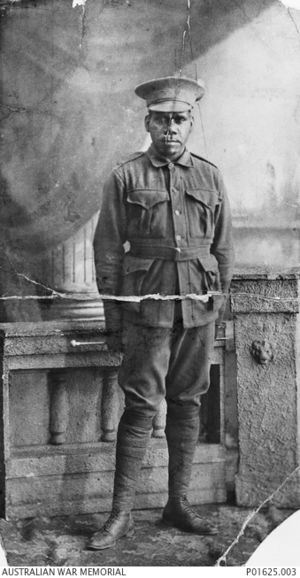William Punch facts for kids
Quick facts for kids
William Joseph Punch
|
|
|---|---|

William Joseph Punch
|
|
| Nickname(s) | Punch |
| Born | 31 March 1880 Bland River, New South Wales, Australia |
| Died | 29 August 1917 (aged 37) Bournemouth, England |
| Buried |
Bournemouth East Cemetery, Boscombe, Bournemouth
|
| Allegiance | Australian |
| Service/ |
Australian Imperial Force |
| Years of service | 1915–1917 |
| Rank | Private |
| Service number | 5435 |
| Unit | 1st Battalion, 53rd Battalion |
| Battles/wars | First World War |
Private William Joseph Punch (born 31 March 1880 – died 29 August 1917) was a brave Wiradjuri soldier. When he was a baby, he was the only survivor of a sad event called the Bland River massacre. He later fought for Australia in World War One.
William Punch's Early Life
William Punch was a Wiradjuri man, born near the Bland River in New South Wales on 31 March 1880.
When he was a baby, William was the only survivor of a terrible event near Wyalong. This happened after some Wiradjuri people were accused of taking cattle that belonged to settlers. In response, a violent attack occurred.
A man named John Siggs found baby William among the victims the next morning. Siggs took William to his home in Pejar. Siggs told people he had found William far away in north Queensland. This story might have been told to hide the true, sad history of what happened.
William grew up with the Siggs family in Goulburn. He went to school there. He was a very good cricketer and also played the violin. Later, he worked on farms.
Serving in World War One
When World War One began, William Punch joined the Australian Imperial Force. He signed up in Goulburn on 31 December 1915. Unlike many other Aboriginal and Torres Strait Islander people who joined, William openly said he was 'Aboriginal'.
After training in Australia, he joined a group of soldiers heading overseas. He sailed on a ship called the HMAT Ceramic on 14 April 1916. He first arrived in Egypt for more training.
In July, William went to England, then sailed to France. He joined the 1st Battalion in Erie Camp, near Ypres in Belgium. He was known to be popular among his fellow soldiers. Some even called him the 'mascot' of his battalion.
In September, his battalion was fighting on the front lines. William was hurt by a piece of shrapnel in his head. After he got better in Boulogne, he went back to his battalion. They soon moved back to France.
William had to leave the front lines again because he got trench foot. He returned to his unit in April 1917. Soon after, he was shot in his right leg.
William's health got worse, and he developed other illnesses. He was taken to Mont Dore Military Hospital. He sadly died of pneumonia on 29 August 1917, when he was 37 years old. Before he passed away, hospital staff helped him write his will. He signed it with an "X".
William Punch was buried with full military honors. His grave is in East Cemetery in Boscombe, Bournemouth, England. Soldiers from the New Zealand Engineers fired their rifles as a mark of respect. Friends, patients, and hospital staff sent flowers to his funeral.
William Punch's Legacy
William Punch's story is shown at the Australian War Memorial in Canberra. His life was remembered during a special ceremony there on 3 December 2014. His name is also on the Crookwell War Memorial.
William's story has become more well-known. It helps people understand the important contributions of Aboriginal and Torres Strait Islander people in Australia's military history. A local theatre group in Goulburn created a play about him in 2015.
Artist Vincent Namatjira also painted William Punch. This painting was part of a traveling art show called Weapons for the Soldier in 2018.

